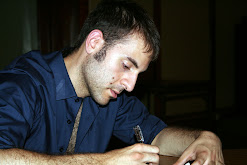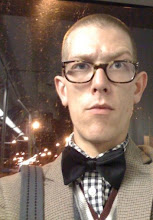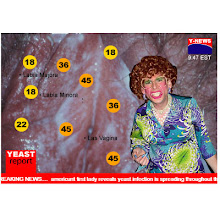
Happy Thanksgiving. I think is important to create space and place for self-reflection, where we can bring the diverse pieces of ourselves together into meaningful wholes. I want to take this opportunity to acknowledge one thing I am very grateful for.
I discovered the art historian Kirk Varnedoe while I lived in Princeton and he taught the History of Art at the Institute for Advanced Study in Princeton.
He is a thinker of big ideas, sometimes at the expense of more refined and subtle scholarship, but he left a lasting impact on me.
One of his ideas that he passed down to Robert Storr (his predecessor at the Museum of Modern Art in New York) the experience of art comes before the ideas in art. First the senses than all the thinking.
He was apposed to "isms" and refused strict interpretations, he thought art was open ended and I agree.
After a long battle with cancer he passed away in 2003.
"Given one minute more to either parse critical theory or stammer
toward the qualities of the individual work of art, I will use the
time for the latter."
-J. Kirk T. Varnedoe (1946–2003)
Thursday, November 22
A FINE DISREGARD
at
11:56 AM
![]()
Sunday, November 18
PINK MOUNTAINS

Drawing from the periphery of everyday life, John Parot makes ordinary objects interesting through unusual transformation. The top five Google searches: sex, god, jobs, music and a rotating cast of celebrities, are recurrent favorites in Parot’s work,stems from everyday experience and the way he make sense of it. Nodding to his heroes from the Velvet Underground, John Waters and project runway, the imagery is at once familiar, but the core of the work lies in what is deeply personal. In his collages meticulous pen lines of tribal tattoos, textiles, African patterns collided with personal perennial motifs, pink triangles, boys lips, hair. Taking on new physicality in wood and foam as landscapes, street signs or mountains . The line jumps off the page and become a drawing in space, soft blue and hot pink painted yarn cruise objects of gay night-life: Cases of Diet-Coke, vodka, porn, obsolete computer disks, VHS, Polaroids, candles, a tape player and mirrors. The installation is it’s instantly striking but given time it slowly reveals humor, puns and ironic wit
at
1:46 PM
![]()
CONGRATULATIONS MELANIE SCHIFF!


Melanie Schiff, one of Chicago's best young photographers, will be in the 2008 Whitney Biennial!
Congratulations girl you are white hot and your show "Underwater Photographer" at Kavi Gupta was awesome:)
"Sleeping Boy" 2002
"Spit" 2006
at
11:49 AM
![]()
QUEER ARCHITECTURE: THE SPACE OF SHADOWS

(Eugene Bavinger House, Norman, Oklahoma, 1950 by Queer Architect Bruce Goff)
Robert MacNeill is a working architect in Chicago. He has worked for Wesley Wei in Philadelphia and is currently an independent thinker and activist. He was the director and designer for "The Cowboy and the Pegasus," an exhibition for Queer Fest Midwest in August 2007.
I have know Rob for years and we have collaborated on many projects together. He is fiercely independent and has a fresh view on the world. Below is our conversation on the state of DESIGN.
JP:What is architecture and design?
RM: Design is making sense of the patterns in the three types of human activity: labor (biological), work (creative), and action (political). We make spaces for these patterns that reflect the activities, and at the same time enhance the experience of acting them out.
JP:What do you see for the future of architecture? Will it change in the digital age?
RM:I think the changes will be fewer than most people think. Let's not flatter ourselves into thinking that we can overthrow the whole history of architecture.
JP:You designed the Queer Fest Midwest art exhibition for 2007, can you talk about the project?
RM:Queer space exists, although it is hard to describe exactly. On one hand, it is formed by things like music and street culture. But it can also be defined by a set of spatial conditions; when I think of queer space I think of shadow and veiling.
JP: Why shadows? I thought being queer was like coming into the light, and coming out for the public to see?
RM: In the modern movement, architects hoped to achieve a transparency - both literal and symbolic - that would eliminate dark spaces, the sublime, and ambiguity. Think of the Phillip Johnson's Glass House or the Farnsworth House; what is it like to live in a glass box with limited boundary between interior and exterior? Queer space is directly opposed to transparent space. It is about refuge and fantasy, limited visibility. There is a definite transition between interior and exterior. This is equally true of the queer body/self. The queer self is never fully revealed to the public. We cast ourselves in shadow. We retreat into the interior.
JP: Like going back into the closet?
RM: The closet has not been eliminated. Maybe we should embrace it. It represents our interior lives.
JP:What do shadows give us?
RM: Shadows are like closets, physically a place to store things, a place to get away and a place for self-refection. And as queer people we like the shadows as a space to be ourselves.
JP: Can you give me an example of queer space?
RM: One example is the store front, which is a window onto the world inside but is also blocked from the world outside. It is temporary, theatrical, mask-like. It does not reveal with accuracy what lies beyond. Store front windows display dreams or fantastic worlds. They are some of the queerest spaces.
JP:You worked on a project to design a pill carrier to honor 20 years of HIV/AIDS activism. Can you talk about how you came to that project?
RM:I thought of the project as a way to give voice to the HIV/AIDS community. It is a very simple gesture that turns the taking of pills into a generative process. Plant seeds are sown as part of taking HIV medication.
There is still a great silence in the HIV/AIDS community. This project gives voice by taking back public space - in this case, with red flowers that appear in unexpected places.
A new map of the city will emerge.
at
11:44 AM
![]()
Saturday, November 17
ON TEXT PAINTING


What is text art?
It is easier to address what it is not: compared to narrative painting or historical painting or portrait painting: text painting non-figurative, it dislocates or disrupts the image and most importantly it can displace the visual.
Text Painting is a genre of painting and is part of the larger group of text art. Lawrence Weiner has a retrospective at the Whitney, but he is a sculptor who uses text as his material.
I asked the chicago-based artist esteban to share some insight into text painting.
JP: Lately you have been making more text painting, why is that?
ES: Text painting has the right spirit, it can be very sarcastic and funny, it has a beautiful simplicity to express huge issues.
JP: Give me an example.
ES: Here is Chicago we had a pretty bad storm a couple weeks ago. At first it started small, drizzling and raining-- but it was late and soon the storm exploded. I climbed into bed and listened to it thundering outside. It is very humbling to think how large nature is. I looked at the storm and just thought, it could destroy me now or the whole neighborhood and it wouldn't change much. When nature shows herself she is more grand than we can imagine. I was thinking about the hurricanes and how fragile we are.
JP: It is very humbling to see the true force of nature. Can art show us something deeper about the world?
ES: No, not deeper, maybe different. It can be a fresh perspective. During that storm I thought of Jupiter, the largest planet. The earth is smaller than most of Jupiter's moons, you can fit countless earths inside Jupiter. And suddenly I thought what a storm on Jupiter must be like. It was unimaginable.

at
7:42 AM
![]()
Thursday, November 15
MASSIVE QUEER CHANGE

In the spirit of change I asked the architect Robert MacNeill to make a proposal for the twenty year anniversary of AIDS Coalition to Unleash Power , ACT UP. His proposal is beautiful simplicitiy:
------------------
Seed-distributing pill case for HIV medication
Proposed: a cluster of pods in silicon rubber for the organization and distribution of pill-based medications for HIV-positive people.
The system includes a removable paper insert that slides into the cluster. It may be personalized with writing to identify pill types, dosages, and times of day. Pills are removed from the pods through perforated tabs in the paper insert. When removed, these tabs serve as a reminder that the enclosed medication has been taken.
The biodegradable tabs are embedded with plant seeds and nutrients that can be freely distributed throughout the city. The result is the dissemination of one of more highly-visible plant types. Bold red flowers begin to appear in unexpected places.
The taking of medication becomes a generative process that gives new visibility to the HIV positive community; in time, a new map of the city emerges.
------------------
Inflation is rising, the value of the dollar dropping and the sub-prime mortgage problems piling up. The forecast for the U.S. economy is bleak. American companies face cutting costs to survive as global competition becomes more fierce. Although research and development sector seems like the first choice for downsizing the message seems clear. Research and the spirit of experimentation is the life blood new ways of thinking. Here in the "New World" our horn of plenty that made America a great nation is ingenuity. Mortgage loan mistakes are the tip of the iceberg and U.S. economy has many more hard hits to come, wide-spread credit card debt might be next. The next decade will belong to emerging markets and ingenuity will win the day.
The message is: Innovate or die.
Innovation is often at the intersection of mathematical logic, scientific questioning, and creative thinking.
One of the most innovative ideas of 2007 comes from Bruce Mau: MASSIVE CHANGE.
Rule 1 from Mau's Incomplete Manifesto:
1. Allow events to change you. You have to be willing to grow. Growth is different from something that happens to you. You produce it. You live it. The prerequisites for growth: the openness to experience events and the willingness to be changed by them.
at
8:51 PM
![]()
Tuesday, November 13
THINK PINK: THERE IS AN ELEPHANT IN THE ROOM


Erik Roldan invited me to contribute a weekly entry to his new blog .
Currently, Rejnowska and Polera is busy developing a report on the challenges and opportunities that emerging artists face in Chicago. In December I will put the first draft of our research online, but in the mean time I want to weigh in on some of the big issues.
Erik requested that my weekly entry be about "queer art" , I happily agreed to his request.
The elephant in the room: what is queer art?
Why should I write about queer art? One reason is that queer art is a mystery. Writing a weekly column is a way to ask some of the many difficult questions that do not have easy answers. To engage in active reflect and make thoughtful reduction to all the information out there about contemporary art.
This blog is about art in the present which is also about art in the everyday, the presence of art in our lives.
To kick off my weekly column I want to hear different ideas : What do you think queer art is?
Queer art for me is work that comes from, contributes to or is part of the queer community. Queer community has American roots in Queer Nation, ACT UP, Gay liberation or even the civil right movement. The comraderie and friendships that arose in early queer activists built one of the great support system in recent history.
The history is complicated and has many turns, but what we are left with is a lot of heritage. Tied to American history because for the past 300 years people have been coming to this America from all over the world. Each different group bringing gifts of different culture, language, religion and ways of seeing the world.
Diversity is one of America's great strengths. Accepting diversity is also something we can improve on.
I want to protect the heritage of the queer community, with its many customs and ways of seeing the world.
And why focus on Queer Art? Because it can show us what is. It reveals a truth for who we were at a moment. It is the presence of mind. Art is sensual first, it expresses the senses at work, the taste, touch and feel and from the sensation comes an explosion of ideas and complexity.
Helen Vendler said "The arts present the whole uncensored human person--in emotional, physical, and intellectual being, and in single and collective form--as no other branch of human accomplishment does."
Ultimately, I hope my entries on queer art can begin to establish a cultural patrimony that many more people will add to.
My first entry will be on John Parot
So let me hear your thoughts.
------------------------
Dmitri Peskov and John Lehrer
in Extended Views,
Dance Chicago 2007
November 7
Athenaeum Theater
at
7:43 PM
![]()





